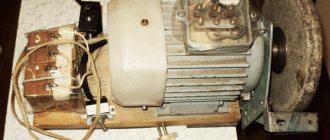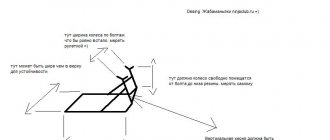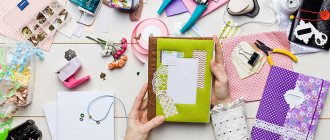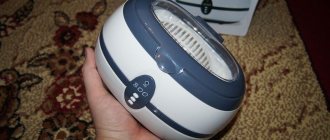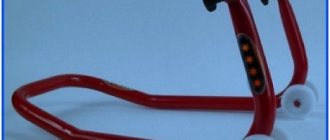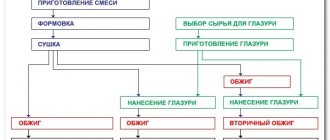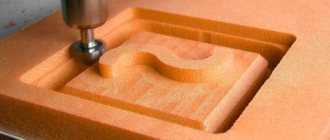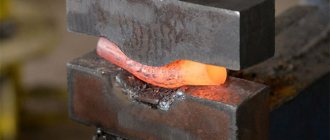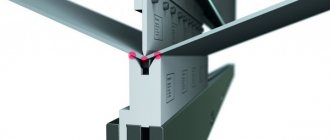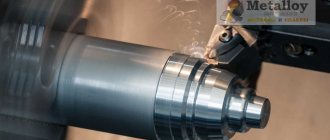Knives for cutting in scrapbooking
Thin metal knives are made from metal with the centers cut out. They are flat on one side and have a thin raised section on the other that highlights the design and serves as a cutting edge.
Digital cutting plotters use special thin knives to cut out images.
Both hand-held machines and digital cutting plotters can be used for scrap.
Rubber mat
A rubber mat is essential when cutting paper or cardboard using a construction or breadboard knife. It protects the table surface from cuts and scratches. The surface of the mat is self-healing, so it is not afraid of cuts and will last a long time. A mat with metric markings will help you ensure that right angles are maintained when working. But the markings of the mat are afraid of glue; if glue gets in, it wears off and smudges. It is advisable to avoid getting glue on the surface of the mat. When choosing a mat, you should be careful and read the description; there are rubber mats that are not intended for cutting with a knife and do not have a self-healing surface.
Manual cutting machine for scrapbooking
To work with a cutting machine, we will need various knives, with which we will do the cutting.
Advice! Cheap knives for scrapbooking die cutting with free shipping can be purchased here.
The process itself goes as follows:
- A sandwich of a plate, paper (this can be scrap paper, tracing paper, craft paper, etc.), a knife with the blade down, and a second plate is placed on the platform.
- Then turn the handle of the machine and make a roll between the shafts of the machine and under the pressure of the shafts the knife cuts through the paper and a cutting is obtained. If one roll is not enough, then you can make two or more, it all depends on the complexity of the cutting (the more openwork the knife, the more rolls you need).
Advantages:
- take up less desk space than digital ones;
- do not require connection to a computer or power supply;
- rapid creation of cuttings;
- ease of learning and operation
Flaws:
- not as many designs as in a digital plotter;
- costs for new knives;
- limited thickness of paper from which it is cut
Inspiration and ideas
Ideas most often come after some events or a change of season. For example, when you want spring and already in February you start doing spring work for March 8 or a flower album, and after September you are waiting for the new year with all your might and immersing yourself in a fairy tale, after an unforgettable trip you sit down to make a travel book or an album about a vacation at sea.
I decided to help you and compiled a rough list of themes for albums, in case some of this inspires you and leads you to some interesting project.
- seaside holiday or travel
- travel book
- one day trip
- birthday
- first year
- significant events of the first 5 years
- wedding
- Love story
- hike
- interesting and favorite places in the world / in the country / in the city
- my furry friend
- dacha quirks or favorite dacha
- one spring/summer/autumn/winter day
- school album
- autumn colors
- my kindergarten
- seasons (4 seasons in one album)
What to do if the felling is poorly cut?
Complex knives (particularly very openwork ones) often require a little more effort to get them to cut correctly. Here are some tips to help you get better results when using them.
- First, try to do rentals more than 1 time (two or more)
- If this doesn't work, you can add a sheet of cardboard as a spacer under the "sandwich" and pass it between the shafts of the machine. This will add a little more pressure and help in those hard to reach places where the knife didn't cut well.
- If this does not help, then you can buy a thin metal spacer to place it under the “sandwich” and pass it between the shafts of the machine.
- If the tips listed above do not resolve the problem, then you may have a faulty blade and need to call the manufacturer for a replacement.
In one of the articles, I already reviewed one of these manual machines, which I use myself - Spellbinders Platinum 6.
There are also analogues: Sizzix Big Shot or We R Memory Keepers Evolution. However, these products are quite expensive and not every beginning scraper can afford them at first. There is an option to buy a cheap analogue scrapbooking machine for cutting, for example, here.
Plain paper
When making cards and albums, one-color thick colored paper is always useful. The best option is pastel paper. This paper comes in various sizes and is sold in art stores. For postcards it is better to take A4 format. It’s cheaper to take A3 and cut it to the required size. You can use cardstock as a basis for postcards and photo backings. Cardstock is a single-color, high-density paper. Sold in scrapbooking stores.
Materials for mixed media
For the “mixed media” style in scrapbooking, there is a specific set of materials that you cannot do without. For different types of mixed media you may need:
- Paste, for example “Vintage Design” (or “TAIR”)
- Primer, for example “Vintage Design” (or “Sonnet” or “TAIR”)
- Sprays such as Ranger Color Wash
- Alcohol ink
- Acrylic paints
- Stencils/masks
- Palette knife
Alcohol ink
Alcohol ink is a fast-drying, transparent, acid-free, dye ink designed to work on glossy (non-porous) surfaces. The alcohol base provides the ink with excellent spreadability and moisture resistance of the paint layer after drying. Alcohol ink dries instantly and is permanent. Not diluted with water. Diluted with colorless filler.
Spray paints
Spray paints are liquid paint in a spray bottle. There are matte and pearlescent sprays. Mix media sprays are concentrated water-based inks, non-toxic, acid-free and suitable for use on porous surfaces: paper, canvas, wood, clay, etc. They can be used on their own, or with stencils and masks.
Acrylic paints
Artistic acrylic paints are paints consisting of three components: pigment, binder and water. The binder is a synthetic material called acrylic polymer emulsion. Acrylic paints have a wide range of advantages: they dry very quickly, have good covering power, a variety of palettes and bright colors. The colors of the paints do not fade over time, as happens with oil paints, and do not fade in the sun, like watercolors.
A mask or stencil is a device used to apply designs or symbols to various surfaces. A mask differs from a stencil only in that it leaves the drawing unpainted, while through the stencil, on the contrary, the area of the drawing is painted over.
A set of stencils for scrapbooking from different manufacturers
Primer (or primer) is necessary for priming any surfaces of canvas, wood, metal, plastic, chipboard, paper and fabric before painting. It creates a thin layer that increases the adhesion of applied paint and other compounds to the surface and protects against moisture. Paste (or texture paste) - used in scrapbooking to form a three-dimensional pattern, which is applied to the surface of the paper through a mask/stencil. It is more convenient to use a palette knife to apply the paste. A palette knife is a special knife or trowel used in oil painting to mix paints, clean the palette, or apply thick paint to the canvas. Palette knives can be purchased at artist supply stores.
Paste, primer, stencil and palette knife
Read more about working in the “mixed media” style in MK: Scrapbooking School. Stage 1. Lesson 4. Mixed media style postcard
Bend Tools
As I already said, you can make a big with a pen, a nail file or a dots. But there are also special tools for this process - a scoring board and a stick (bone).
There are a lot of different bones and boards, their prices are also different, but the meaning is the same. The board is a tablet with chamfers applied at equal distances from each other. Working with it is very simple: just place the workpiece on it and draw along the line of one of the chamfers with a special stick, which most often comes with the board. Thus, the paper is pressed into the chamfer and a mini fold is obtained along which it must be folded.
The bones also come in different shapes; here the craftswoman decides by selection which one is more convenient for her to work with.
You can buy a board and scoring stick here.
Main technical characteristics
Processed workpiece
The operational and technical parameters of a particular model are the determining factors for choice. They affect the functionality of the equipment. Therefore, before purchasing, it is recommended to conduct a detailed analysis of the parameters of several models in order to choose the best option.
All devices of this type are desktop. Dimensions and weight in this case are not significant. It is important to take into account the ergonomics of the location of the main components - the pressure table, the handle for rotating the roller. They must be convenient for use in specific conditions. You should also pay attention to the material used to make the moving mechanisms. Plastic gears will not be able to perform their functions for a long time.
Main technical characteristics of cutting and embossing machines:
- dimensions of the working platform. For the vast majority of models it is 1.6*1.5*36 cm. Additional devices to increase this parameter are impractical;
- dimensions of the support plates. They determine the maximum allowable size of the workpiece being processed;
- set of knives. They have different shapes. To increase the capabilities of the device, you can purchase additional kits. It is important to take into account the requirements of the machine manufacturer for the material used to make the knives and their thickness.
In addition, the package includes an introductory booklet that shows the procedure for proper operation of the device. It also indicates the most common examples of using the machine for processing various materials.
The average cost of such a machine is 14,000 rubles. The price may vary depending on the configuration and brand of the manufacturer.
Hot embossing materials
Hot embossing kit
To use the hot embossing technique you will need:
- embossing hair dryer
- embossing powder
- acrylic block
- stamp
- transparent ink pad for embossing
Embossing powder is a special powder that melts when exposed to high temperatures.
Embossing powder
Eyelets
Not everyone knows what eyelets are, although everyone has probably seen them - in clothes, notebooks and books. They are used to protect the edges of the hole from wear. In scrapbooking, eyelets are used to decorate holes made with a hole punch and to make covers.
Eyelets can serve as decorative material
Let's take a closer look at what functions eyelets can perform:
- Strengthening holes for album or notepad rings.
- Use as a decorative element in a single or group design.
- Fastening jewelry by tying it with a cord or thread through a hole.
Overview of the varieties and functionality of eyelets
There is a special tool for making holes and inserting eyelets - a cropodile. It varies in the complexity of its design: the stationery one is simple, and the more functional one is the cropodile for scrapbooking. The most simplified version does not allow punching thick sheets of cardboard and has a limited distance from the edge of the sheet. A professional device has great capabilities, but its price is much higher.
Special devices significantly simplify the installation of eyelets:
- Simultaneously making holes and attaching the grommet.
- Precise installation in the right place.
- Creating holes in materials of various densities used in scrapbooking.
- Creation of large diameter holes.
Advantages and disadvantages of grommet installation tools
Some people may like the mechanization of work in scrapbooking, but others may not. But technological progress cannot bypass any sphere of life, including handicrafts.
